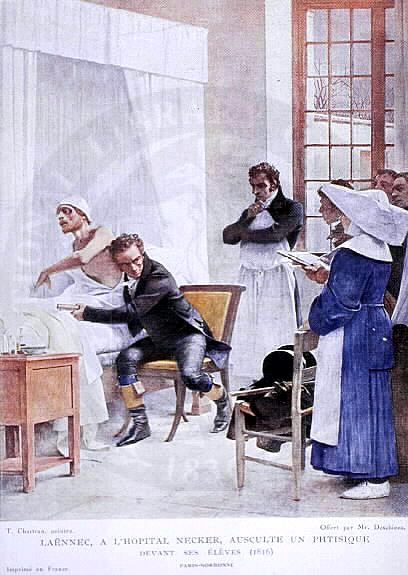RETURN
TO PREVIOUS PAGE

Artist: Theobold
Chartran
Oil on
canvas
Location of Original National Library of Medicine, Bethesda,
Maryland
Laennec Listening with his Ear Against the Chest of a Patient at the Necker Hospital
As
the title explains, the painting depicts René
Théophile Hyacinthe Laënnec, 1781-1826, French
physician, in a hospital room, his ear pressed to the chest
of a male patient, who is sitting up in his bed. In his left
hand he holds an early model of the stethoscope. Three other
figures appear to the back and right: one is likely another
physician, another is a sister/nurse. While connected with
the Necker Hospital in Paris he invented the stethoscope,
which he described, together with the symptoms he had noted
through its use, in his classic book De l'auscultation
médiate (2 vol. 1819; tr. 1821). His method of
auscultation for detecting diseases of the chest, together
with the procedure of percussion developed by Leopold
Auenbrugger, form the basis of the modern diagnostic
technique.
The
stethoscope was one of the first technological innovations
in medicine and its advent was accompanied by some of the
same concerns that are raised about 20th century
technologies. Physicians in Laennec's day were concerned
about two aspects of using a stethoscope: the stethoscope,
which allowed for "mediated auscultation," removed the
patient from direct physical contact with his/her physician,
and the stethoscope allowed for finer and more accurate
diagnoses, which could rob patients of hope for
recovery.
The
invention of the stethoscope also intensified the ongoing
battle between physicians and surgeons. Physicians were the
learned, professional half of the medical profession;
surgeons were considered by physicians to be mere
technicians. Some physicians feared that using instruments
such as a stethoscope sullied their higher status, the art
of their profession.